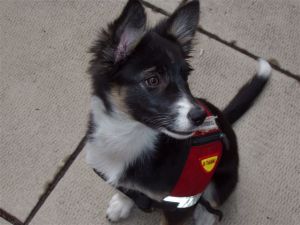When I brought Sky home from the farm in North Carolina where she was born, I began immediately to prepare her for her future work as a service dog. Well, in fact, I began before I brought her home. I began on the plane. I had arranged to fly her as a service dog in training since the moment she was mine, that’s what she was. As such, though I had a Sherpa bag, I was able to keep her out with me except for take-off and landing. At 8 weeks of age, I began to show Sky that her job was to be with me, knowing that as she matured, became more observant and as I gave her reinforcement when she got even a small step right, she would figure out what the job was.
When training complex behaviors, when training any kind of behaviors, it is important for the trainer to have several things in mind. You must know where it is you are heading. In other words, you must know the goal, what you want the dog to do eventually. And certainly, you must not do things early on that will impede that goal later on. If, for example, you do not want your Saint Bernard to loll and drool on your couch when he weights only-god-knows how many pounds as an adult, you must not let him up on the couch when he is a youngster. Next you need to be able to break down the behavior into steps, steps your dog can comprehend and learn, and to teach those steps methodically, one at a time, stringing them together as is appropriate. Thus the trick “Say Your Prayers” would start with “Paws Up” and only later on, would your dog do Paws Up while seated and then eventually would dip his head between his paws as if in prayer. In addition, the trainer must understand how the dog interprets each step in his training. This is not so urgent when teaching a trick, other than that the mood be jolly and the dog be jolly as well. But for the service dog, this is crucial.
I have been told many times by people in need of a service dog that they had a dog they wanted to train, that the dog was one or two or even three, and that they went to work or on a business trip or out to dinner and left the dog at home. How does the dog interpret this? He thinks, “I am not needed.” It is by being with his person 24/7 with as few exceptions as possible that a dog comes to see his work, that he takes on the responsibility being offered and that he takes joy in learning his job and in doing it well.
Everything you do is analyzed by your dog. Ah, he thinks, he told me not to go on the couch, but he doesn’t seem to pay attention when I do. Oh, he thinks, when she says sit, she means sit. And so on. Little things, big things, your dog is always getting the message, even if the message your are giving is not a conscious one, or even if the message is far from what you think it is. Let your dog take your favorite spot, get aggressive over a toy with no consequences, disobey your commands, protect his dinner, not come when called unless he feel like it, he’s got the message even if you don’t. Show your dog appreciation for cheerful obedience when it’s called for, for the comfort of his body next to yours when you are in pain, for blocking a toddler from a fall, for cheering up a sad friend, for sharing toys with equanimity, for moving over when you want to sit near the lamp, he’ll get those messages, too.
He’s not just a wagging tail, a fetching machine, a kissing fool. There is nothing, absolutely nothing, more important to him than to figure out what’s what in his own world, this philosopher, this interpreter of all he sees, this thinking being.


